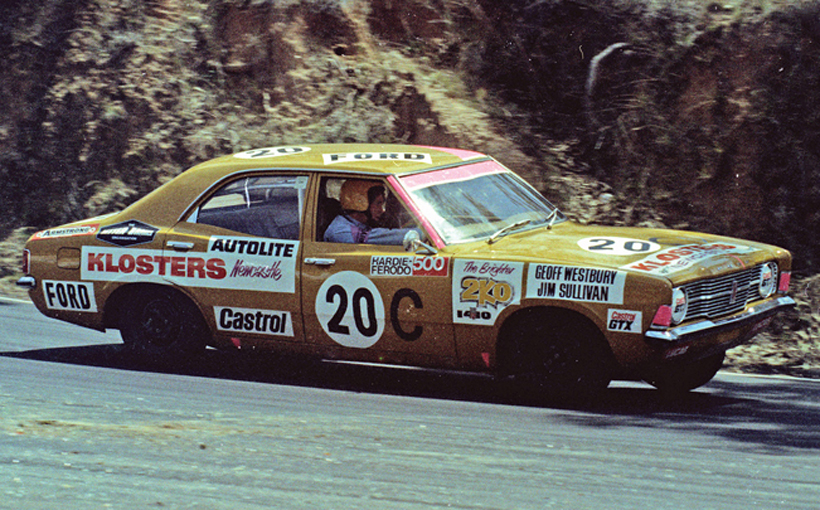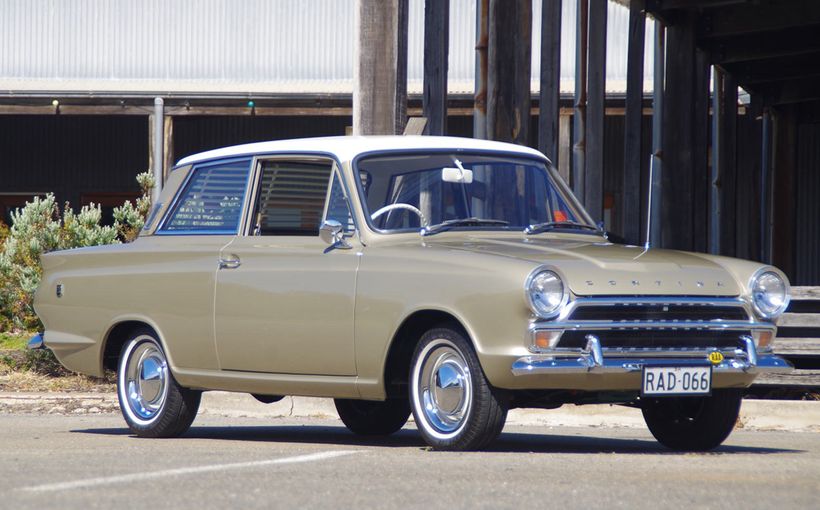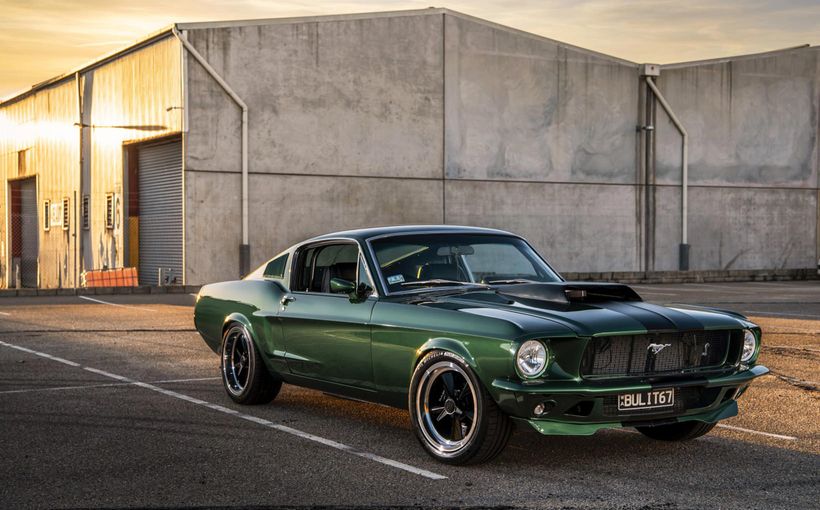Ford TC Cortina: Last stand for Henry’s original Bathurst ‘Supercar’

Ford’s legendary Mk I Cortina dominated the early years of the annual Bathurst 500, being first car across the line three years in a row (1963-65) before Ford’s big V8-powered Falcon GT proved there was no substitute for cubic inches. However, years after its glory days, the first and only appearance of a Mk III TC Cortina closed an important chapter in Great Race history.
Finishing eighth in class and 35th outright in the 1971 Hardie-Ferodo 500 was hardly worthy of headlines. Even so, the solid and fuss-free performance by Geoff Westbury and Jim Sullivan in Australia’s toughest race for production cars was an historical ‘book-end’ for the Cortina at Bathurst and proved that the TC’s reputation for poor quality and handling didn’t apply in all cases.
Indeed, the lone Cortina was one of only 45 finishers from the 60 cars that started the race. And although it was outgunned by the rapid Mazda RX-2s and Torana GTRs which dominated its showroom price-based class it did enjoy a trouble-free run, much to the delight of the dealership which supplied it.
Klosters Ford, which in 1969 also backed reigning Bathurst champion Bruce McPhee in a Falcon GT-HO that finished second outright, was one of many Ford dealerships keen to raise buyer interest in Ford’s latest Cortina following its release in August 1971.

Based in Newcastle on the NSW mid-north coast, the Kloster family knew the positive influence that motor sport – particularly the Bathurst 500 – had on potential car buyers following its strong showing with McPhee, so the Cortina’s reliability in the race was fully exploited.
“I do remember they made a big thing out of the fact we didn’t need to open the bonnet once during the race,” Jim Sullivan told Shannons Club as he reflected on his unusual 1971 Bathurst drive.
“Klosters put the Cortina on display in their showroom, proudly claiming that it had just completed Bathurst without the bonnet being raised. They were selling the idea that here was a brand new car which had shown faultless reliability at Bathurst, which really meant something when we were competing in the same cars that anyone on the street could buy.”
Ford’s new TC Cortina was the third generation of Ford’s globally popular mid-sizer, even though the traditional ‘Mk III’ model reference was not used in Australia. The TC shared the same overall length of its Mk II predecessor (which had also competed at Bathurst in the late 1960s) but had a 75mm longer wheelbase and was considerably wider (100mm) and heavier.

The TC (or Taurus-Cortina in reference to its shared German/English chassis platform) was launched in L and XL model grades. Engine choices comprised the venerable 1.6 litre ‘Kent’ pushrod four and optional belt-driven SOHC 2.0 litre ‘Pinto’ four, which would later power the highly successful Escort RS2000.
This engine in TC form was rated at 112 bhp which was enough grunt to push the ‘big’ Cortina to a claimed top speed of 100 mph (160 km/h). The TC’s stock three-on-the-tree manual could be optioned up to a three-speed auto or four-speed manual with floor shift.
With a kerb weight of 1025 kgs, the new Cortina offered attractive styling with Ford’s signature ‘Coke bottle’ hip line prominent in the rear passenger door profile. Underneath was a typical mass-produced combination of twin-A arm front suspension, front disc brakes and a coil-sprung, drum-braked live rear axle.
Ford would later fit the Falcon’s more powerful but much heavier inline six cylinder engines to these cars in response to Holden’s LC/LJ Torana. However, the weight distribution was badly affected and they could never match the more balanced handling of the original four cylinder versions.

When winning isn’t everything
As Jim Sullivan explained, the decision by Klosters Ford to back a TC Cortina at Bathurst in 1971 had more to do with impressing potential Cortina buyers with its reliability and durability than any realistic expectations of a class win.
The model chosen for the Hardie-Ferodo 500 campaign was a 2000 L, which logically combined the lightest weight of the entry level ‘L’ model optioned up with the more powerful 2.0 litre (2000) engine and four-speed manual gearbox.
Even so, ticking those boxes on the order sheet would not be enough to bridge the performance gap to cars like Mazda’s potent 12A rotary-powered RX-2, Holden’s six cylinder LC Torana GTR and Ford’s Escort Twin-Cam which were expected to dominate Class C for cars costing $2501-$3150.

“The guy that organised it, (Klosters salesman) Geoff Westbury, was someone I’d got to know through car clubs over the years and he got the entry sorted and asked me to drive with him,” Jim Sullivan explained.
“My dad ran a tyre shop in Newcastle at the time and Geoff always bought his tyres from him too. It made sense for Geoff to choose a TC Cortina because it had only recently gone on sale and to run one at Bathurst was a good promotion for Klosters.”
Back in the mid-1960s Jim Sullivan was one of many talented Aussies that followed in the tyre tracks of Jack Brabham in chasing fame and fortune in European racing. After winning the first Australian ‘Driver to Europe’ award, Sullivan was to have been mentored by the great Reg Parnell but he passed away before Jim arrived the UK.

After lowering Jim Clark’s Lotus-Cortina lap record at Crystal Palace in a Holbay-engined Austin A40, Sullivan was rewarded with an F3 drive resulting in several wins and a sparkling second place to F1 ace Piers Courage in the Martini International at Silverstone. However, sponsorship problems ended Sullivan’s hopes of progressing further and he returned to Australia, enjoying the odd motor sport drive while building a successful media career (Jim was news director at NBN television for 20 years).
“From memory there wasn’t a lot of preparation done to the Cortina,” Jim continued. “Obviously they had to put some kind of a roll cage in it (and Hardie-Ferodo competition brake pads/linings under the rules) but she was pretty much off the showroom floor.
“Brakes were often a problem at Bathurst in those days but they worked surprisingly well and we didn’t have any problems with them in the race. The trick on those days was getting good brake fluid. Bruce McPhee put us onto the idea of boiling the fluid first to eliminate any moisture (water) that may have been absorbed before using it in the car.
“We also ran Michelin XAS radials (the top Mazdas and Toranas in Class C used special competition tyres that year). A lot of people were still running radials at Bathurst in those days because they could do the whole race without needing a tyre change.”

The ultimate Sunday drive
Images of the Westbury/Sullivan Cortina show that it was well supported by local media interests in Newcastle. In addition to decals displaying Klosters Ford and the usual automotive product suppliers, the steel city’s radio station 2KO and resident TV station NBN 3 were also prominently displayed (Sullivan hosted a weekly motor sport segment on NBN 3’s weekend sports show).
“I don’t think I even drove the car on the street until we turned up at Bathurst for practice,” Jim recalled of the days when the Hardie-Ferodo 500 was a two-day race meeting, with practice/qualifying on Saturday and the race on Sunday. “The team had friends in Blayney so we stayed in a pub there and drove to the circuit each day.”

As expected, the Mazda RX-2 rotaries, Torana GTRs and Escort Twin Cams were the pace setters in Class C. The Westbury/Sullivan Cortina qualified second last in class and 49th outright, in a massive field of 60 cars. This meant that Jim would start the race from Conrod Straight, back in the days when the starting grid would stretch right around Murray’s Corner where a relay flagman would wave a second starter’s flag for the backmarkers.
Although the Cortina did not have the raw speed required for a class win, it did enjoy a consistent and trouble-free run to its eventual 8th place in Class C and 35th outright. The performance disparity between the Cortina and the class-winning Mazda RX-2 rotary can be seen in the Japanese car’s huge winning margin, having completed 117 laps (of 130) compared to the Cortina’s 110 laps. Such glaring performance disparities were common at Bathurst, though, when classes were based purely on retail prices.
“That was a willing little engine,” Jim fondly recalled of the 2.0 litre SOHC four. “I can’t remember the revs we were using but we certainly drove it flat-out all day and it never missed a beat. I drove pretty much the whole race, too, which you could do in those days. I think Geoff only drove about half an hour and I did the rest.

“With those standard production cars, especially on (street) radials, you could just drive them to the limit without there being an issue with tyres getting too hot or too cold or losing traction the way proper racing tyres do. You’d just get so tuned into the car and the circuit that you were using every inch of the road and ending up with very consistent laps. That was back in the days of hand-timing of course, but at one stage in the race I did 15 laps in a row that were all within one tenth of a second.
“On skinny road tyres you had some pretty big slip angles of course and the car had plenty of attitude in the faster corners. I remember going across the top between Reid Park and McPhillamy Park; you didn’t have much left in the way of traction by the time you came out of McPhillamy flat. I remember that car was pretty good from Skyline down to Forrest’s Elbow. It was faster than a number of the bigger cars down through there.
“The Cortina had bucket seats, or individual front seats at least, so you weren’t sliding around inside as much as you would on a bench seat. I don’t remember doing much wheel-twirling or having to take a second grab at the wheel or anything like that. It had reasonably direct steering.

“They weren’t a bad thing really. I drove another one with a guy in the (1971) Dulux Rally and we actually won our class. They (the four cylinder TCs) did handle pretty well. I remember in the Dulux passing things like Falcon GTs under the Dunlop Bridge at Surfers Paradise and at places like Oran Park it was also pretty effective.”
Jim Sullivan’s media background meant he was also a regular contributor to Racing Car News magazine at the time. In the November 1971 issue, RCN’s extensive coverage of the Hardie-Ferodo 500 included a short break-out piece by Jim titled “On the inside…looking out”. Today it remains as fresh as it was written more than four decades ago and gives some revealing insights into what it was like to compete with 60 other cars at Bathurst in those days:

“Driving the two-litre Cortina in the ‘500’ and lapping between 3:15s and 3:18s meant that the fast machinery was coming past fairly frequently, giving me a great chance to observe some of the differences between drivers and cars.
“The three-speed gearboxes of the Valiants were very obvious coming out of Hell Corner on the run up Mountain Straight. HO’s and XU1’s would fly past the Cortina out of the corner, but the Chargers seemed to take a good hundred yards or so before they got in their stride.
“Moffat was unbelievably gentle on the car. After my first stint at the wheel I asked our crew what had gone wrong with Moffat’s car – he just did not seem to be trying, compared with the antics of some of the other Falcons.
“Col Bond (Torana XU-1) and David McKay (Falcon GT-HO) stood out for the way they carved through traffic. Quite a few drivers in the faster cars seemed to be happy to lift off if they could not be just where they wanted to be on a corner, but McKay and Bond consistently just found another way around.
“The smell of the big Falcons as they went past was unbelievable – it was the automotive equivalent of a sweaty draught horse.
“The rear suspension of the Chargers has a surprising degree of lateral movement. Sitting right behind them on Hell Corner you could see the left-hand wheel almost outside the body-line as the springs distorted. It doesn’t foul the guard, because body roll keeps it above the tyre.
“Towards the end of the race the Falcons seemed to be getting short on rear shockers – they appeared to be pitching more and suffering from more axle tramp.
“My prize for the best trick goes to the fire marshall who dropped his fire extinguisher down the bank in The Cutting during practice, leaving a few of us to dodge it as it rolled down the road.”

Although Ford’s Cortina had a trouble-free run in its final appearance at Bathurst, there was one incident which could have caused some headaches.
“After practice finished it was a bit cold so I put a rally jacket on and locked the car up, but when we came back I couldn’t find the keys,” Jim said. “I put my hand in the pocket of my jacket and found an empty chip packet in there. I thought I’d thrown that in the garbage bin, but with the adrenalin running straight after practice I realised that I’d actually thrown the keys into the garbage instead!
“I said to the crew ‘I bet you’ll find them in that rubbish bin over there’ which they didn’t believe at first, but when they tipped it over (a 44-gallon drum) and emptied it out, sure enough there were the keys!”









